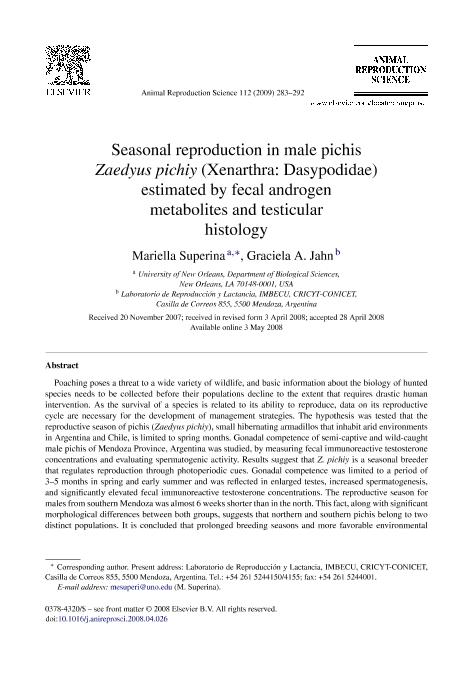Mostrar el registro sencillo del ítem
dc.contributor.author
Superina, Mariella

dc.contributor.author
Jahn, Graciela Alma

dc.date.available
2019-07-26T16:14:09Z
dc.date.issued
2009-06
dc.identifier.citation
Superina, Mariella; Jahn, Graciela Alma; Seasonal reproduction in male pichis Zaedyus pichiy (Xenarthra: Dasypodidae) estimated by fecal androgen metabolites and testicular histology; Elsevier Science; Animal Reproduction Science; 112; 3-4; 6-2009; 283-292
dc.identifier.issn
0378-4320
dc.identifier.uri
http://hdl.handle.net/11336/80384
dc.description.abstract
Poaching poses a threat to a wide variety of wildlife, and basic information about the biology of hunted species needs to be collected before their populations decline to the extent that requires drastic human intervention. As the survival of a species is related to its ability to reproduce, data on its reproductive cycle are necessary for the development of management strategies. The hypothesis was tested that the reproductive season of pichis (Zaedyus pichiy), small hibernating armadillos that inhabit arid environments in Argentina and Chile, is limited to spring months. Gonadal competence of semi-captive and wild-caught male pichis of Mendoza Province, Argentina was studied, by measuring fecal immunoreactive testosterone concentrations and evaluating spermatogenic activity. Results suggest that Z. pichiy is a seasonal breeder that regulates reproduction through photoperiodic cues. Gonadal competence was limited to a period of 3-5 months in spring and early summer and was reflected in enlarged testes, increased spermatogenesis, and significantly elevated fecal immunoreactive testosterone concentrations. The reproductive season for males from southern Mendoza was almost 6 weeks shorter than in the north. This fact, along with significant morphological differences between both groups, suggests that northern and southern pichis belong to two distinct populations. It is concluded that prolonged breeding seasons and more favorable environmental conditions in northern Mendoza favor a prolongation of the reproductive season that may allow pichis to breed later in the year, thus maximizing reproductive opportunities.
dc.format
application/pdf
dc.language.iso
eng
dc.publisher
Elsevier Science

dc.rights
info:eu-repo/semantics/openAccess
dc.rights.uri
https://creativecommons.org/licenses/by-nc-sa/2.5/ar/
dc.subject
Fecal Hormones
dc.subject
Fecal Testosterone Metabolites
dc.subject
Pichis-Argentina
dc.subject
Spermatogenesis
dc.subject.classification
Biología Reproductiva

dc.subject.classification
Ciencias Biológicas

dc.subject.classification
CIENCIAS NATURALES Y EXACTAS

dc.title
Seasonal reproduction in male pichis Zaedyus pichiy (Xenarthra: Dasypodidae) estimated by fecal androgen metabolites and testicular histology
dc.type
info:eu-repo/semantics/article
dc.type
info:ar-repo/semantics/artículo
dc.type
info:eu-repo/semantics/publishedVersion
dc.date.updated
2019-06-10T21:44:29Z
dc.journal.volume
112
dc.journal.number
3-4
dc.journal.pagination
283-292
dc.journal.pais
Países Bajos

dc.journal.ciudad
Amsterdam
dc.description.fil
Fil: Superina, Mariella. University Of New Orleans; Estados Unidos. Consejo Nacional de Investigaciones Científicas y Técnicas. Centro Científico Tecnológico Conicet - Mendoza. Instituto de Medicina y Biología Experimental de Cuyo; Argentina
dc.description.fil
Fil: Jahn, Graciela Alma. Consejo Nacional de Investigaciones Científicas y Técnicas. Centro Científico Tecnológico Conicet - Mendoza. Instituto de Medicina y Biología Experimental de Cuyo; Argentina
dc.journal.title
Animal Reproduction Science

dc.relation.alternativeid
info:eu-repo/semantics/altIdentifier/doi/http://dx.doi.org/10.1016/j.anireprosci.2008.04.026
dc.relation.alternativeid
info:eu-repo/semantics/altIdentifier/url/https://www.sciencedirect.com/science/article/pii/S0378432008001577
Archivos asociados
